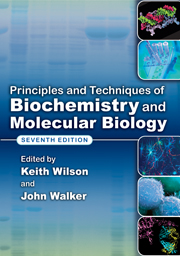Book contents
- Frontmatter
- Contents
- Preface to the seventh edition
- List of contributors
- List of abbreviations
- 1 Basic principles
- 2 Cell culture techniques
- 3 Centrifugation
- 4 Microscopy
- 5 Molecular biology, bioinformatics and basic techniques
- 6 Recombinant DNA and genetic analysis
- 7 Immunochemical techniques
- 8 Protein structure, purification, characterisation and function analysis
- 9 Mass spectrometric techniques
- 10 Electrophoretic techniques
- 11 Chromatographic techniques
- 12 Spectroscopic techniques: I Spectrophotometric techniques
- 13 Spectroscopic techniques: II Structure and interactions
- 14 Radioisotope techniques
- 15 Enzymes
- 16 Principles of clinical biochemistry
- 17 Cell membrane receptors and cell signalling
- 18 Drug discovery and development
- Index
- Plate section
- References
13 - Spectroscopic techniques: II Structure and interactions
- Frontmatter
- Contents
- Preface to the seventh edition
- List of contributors
- List of abbreviations
- 1 Basic principles
- 2 Cell culture techniques
- 3 Centrifugation
- 4 Microscopy
- 5 Molecular biology, bioinformatics and basic techniques
- 6 Recombinant DNA and genetic analysis
- 7 Immunochemical techniques
- 8 Protein structure, purification, characterisation and function analysis
- 9 Mass spectrometric techniques
- 10 Electrophoretic techniques
- 11 Chromatographic techniques
- 12 Spectroscopic techniques: I Spectrophotometric techniques
- 13 Spectroscopic techniques: II Structure and interactions
- 14 Radioisotope techniques
- 15 Enzymes
- 16 Principles of clinical biochemistry
- 17 Cell membrane receptors and cell signalling
- 18 Drug discovery and development
- Index
- Plate section
- References
Summary
INTRODUCTION
The overarching theme of techniques such as mass spectrometry (Chapter 9), electron microscopy and imaging (Chapter 4), analytical centrifugation (Chapter 3) and molecular exclusion chromatography (Chapter 11) is the aim to obtain clues about the structure of biomolecules and larger assemblies thereof. The spectroscopic techniques discussed in Chapters 12 and 13 are further complementary methods, and by assembling the jigsaw of pieces of information, one can gain a comprehensive picture of the structure of the biological object under study. In addition, the spectroscopic principles established in Chapter 12 are often employed as read-out in a huge variety of biochemical assays, and several more sophisticated technologies employ these basic principles in a ‘hidden’ way.
In the previous chapter, we established that the electromagnetic spectrum is a continuum of frequencies from the long wavelength region of the radio frequencies to the high-energy γ-rays of nuclear origin. While the methods and techniques discussed in Chapter 12 concentrated on the use of visible and UV light, there are other spectroscopic techniques that employ electromagnetic radiation of higher as well as lower energy. Another shared property of the techniques in this chapter is the higher level of complexity in undertaking. These applications are usually employed at a later stage of biochemical characterisation and aimed more at investigation of the three-dimensional structure, and in the case of proteins and peptides, address the tertiary and quaternary structure.
Information
- Type
- Chapter
- Information
- Principles and Techniques of Biochemistry and Molecular Biology , pp. 522 - 552Publisher: Cambridge University PressPrint publication year: 2010
